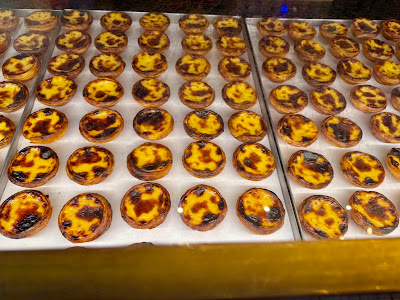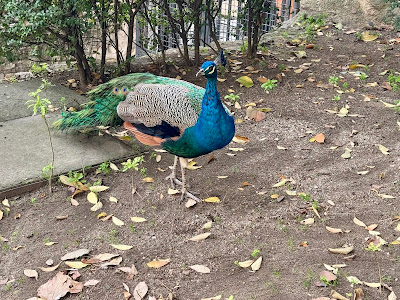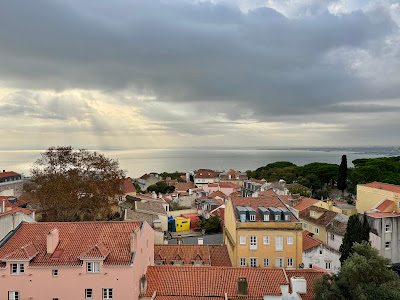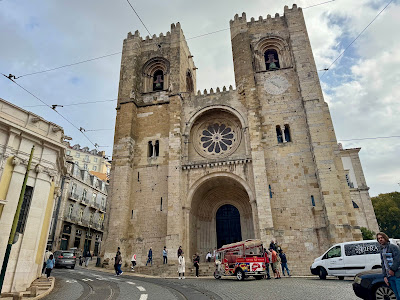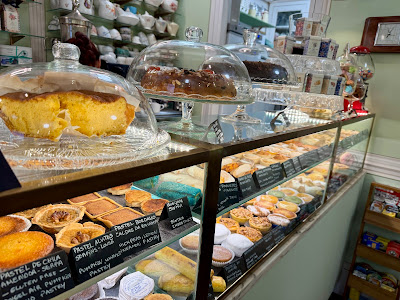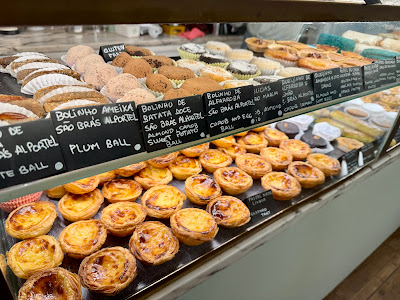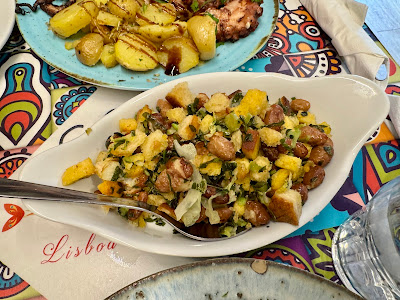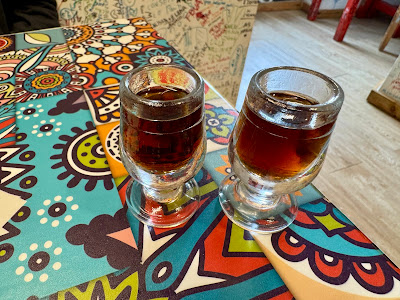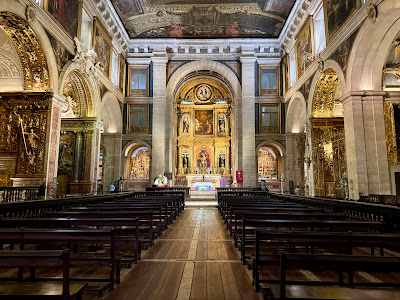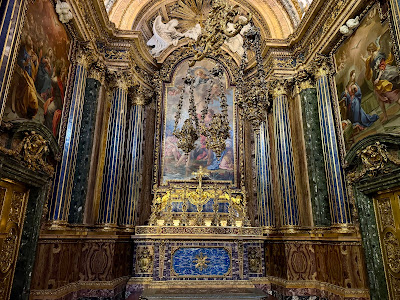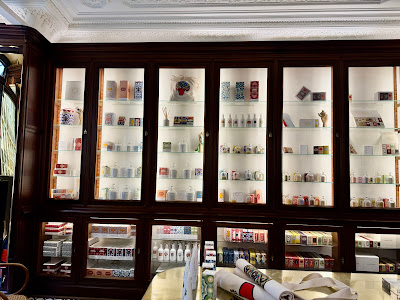Lisbon, Portugal Day 2
Anyway we arrived at the place a little before it was open. The place was called As Bifanas do Afonso, or The Bifanas of Afonso in English. As their name suggests, they specialize in bifanas, pork steak sandwiches.
In a very small shop, something in a big pan was simmering and smelled very nice at 8'o clock in the morning. The man there made a sandwich with the simmered pork and a roll for J.
The sandwich was cut in half. The cross section looked simple: pork and a roll. However, the pork's flavor was rather complex. Atlas Obscura describes the sandwich as "thin slices of pork, braised in a mix of white wine, garlic, bay leaf, and lard (and, it’s said, Sprite), stuffed in a chewy Portuguese-style roll." I tasted a little bit. The pork filling was amazingly flavorful as well as very tender and moist. Not fatty or dry at all. The roll was perfect for the filling. The hot and savory freshly-made sandwich was J's best breakfast in Lisbon, I believe.
After then we went to Nata De Lisboa, a shop of Pastéis de Nata. It looked that every single bakery, pastry shop, cafe and grocery store in Lisbon offers Portuguese egg tarts. It was easy to find one but you would need some research and luck to find your favorite one. This place was one of our friend's recommendations. Many egg tart shops seemed to be open as early as 8:30 am. A or two tarts easily became my breakfast.
There were variation of Pastéis de Nata although I tasted only traditional tarts on this trip.
One for me and one for J. The custard cream was warm and creamy. It was as tasty as one we had a day before. Actually I wasn't sure how it was exactly different from the other.
There was another egg tart shop nearby. Castro is a well-reviewed Pastéis de Nata bakery chain. I tried their egg tart right after one by Nata De Lisboa. It was nicely warm, too. Castro's custard filling was definitely sweeter than Nata De Lisboa's, though. Maybe the top was more caramelized?
Anyway our breakfast was done. It was time to climb up to the hill-top castle, Castelo de São Jorge.
Castelo de São Jorge was built by the Moors as a fortress in the 11th century. In the 12th century, the castle was captured by Christian forces in the Siege of Lisbon, and became a royal palace and residence of the Portuguese monarchy. Today it is a national monument, museum and archeological site. Actually it was more like a garden with some old castle ruins. There was a building, which was supposed to be the remains of the residence of Portuguese kings and today be an archeological museum. However, it was under construction and closed unfortunately.
A peacock was wandering...
There was another one.
And another one...
I never guessed that a couple of dozens of peacocks were the current residents of the castle property.
After meeting a lot of peacocks, we finally found the gate to the remaining walls and towers of the fortified castle.
Inside of the wall was pretty much empty. We climbed up to the top of the walls and the towers and had nice views of the city of Lisbon for a while.
There was an archeological center behind the castle walls, which is supposed to be a project of "Musealisation of archaeological structures from from the Iron Age, Islamic period, the Middle Ages and the Modern Age." The center also looked closed, though.
The statue of Afonso Henriques, the first king of Portugal, who conquered Lisbon from the Moors stood in the center of the square that was built as an enlargement of the Citadel to the south and was built in the 16th or possibly the 17th century. The square was another nice lookout.
It was time to say Good-bye to the peacocks. They were the highlight of the castle visit for me.
We quickly stopped by a church right next to the castle exit. The church of Santa Cruz was originally built in the late 12th century and was rebuilt soon after it was destroyed by the 1755 earthquake.
Our next stop was Lisbon Cathedral, located at the southern foot of the castle hill. Going down was an easy task!
Lisbon Cathedral, also known as Sé de Lisboa is the oldest church in the city. The construction started in 1147, the same year that Afonso I seized Lisbon from the Moors, on the site where a Muslim mosque would stand.
The self-guided tour in the church started with the Treasury on the upper floor.
On the same floor, the High Choir gave us the view of the entire central nave and a very close look at the rose window, which was designed in 1930s, based on restoring several fragments of the Medieval rose windows that was destroyed in the 1755 earthquake.
The transept space miraculously retains the original Romanesque vaults. There were several chapels behind the high alter.
When we stepped out from the cathedral, it was lightly raining. We decided to escape to a cafe, one of our friend's recommendations for Pastéis de Nata. We carefully walked on the dangerously slippery wet mosaic sidewalks, and safely arrived at Casa São Miguel.
The cafe was tiny and packed with various little baked goods, and of course I had a Portuguese egg tart. J had a savory tart. It was a venison tart, maybe?
This was my forth Portuguese egg tart. It tasted as good as the others. At that time I thought that every tart might be slightly different from each other but generally they were kinda identical.
When we left the cafe, the rain stopped. It was almost noon and already time for lunch. We tried Lisbon Tu e Eu, a restaurant that serves traditional Portuguese dishes, located near the cafe.
We were seated on the small upstairs dining room. The walls were covered with colorful signs by guests. Portuguese mild winter let the windows be wide open in December.
We ordered three dishes to share. One was Bacalhau à Brás, desalted and shredded Portuguese salt cod, mixed with eggs, onions, and matchstick potatoes and topped with olives and parsley. It was very tasty with a pleasant creamy texture. I haven't had a dish like this before.
And, grilled octopus. They were fine but probably not the best in my life. I am very picky about octopus.
Our server kindly brought two complimentary glasses of Ginja at the end. I sipped a bit and gave J the rest. It tasted like a cough syrup...
We wandered the downtown to digest the rich lunch for a while. We walked up and down the slopes and did some window-shopping and actual shopping.
A soap store that I was interested in was close for lunch break. We waited in Church of Saint Roch near the store for while. The 16th century church was one of the few structures in the city to survive mostly intact after the 1755 earthquake.
There were several lavish baroque chapels. Especially, the chapel of St. John the Baptist was generously covered up with gold, ivory, lapis lazuli and agate, commissioned by King John V in 1740 and today it's known as the most expensive chapel in Europe. The center wall painting is not actually a painting but mosaic.
The soap store opened its door again for the mid afternoon. Claus Porto has been producing their iconic luxurious soup bars since 1887 when the two german businessman, Ferdinand Claus and Georges Schweder created the first soap and fragrance factory in Portugal. The store looked as elegant as the packaging design of their products. After sniffing several glass jars covering different soap bars repeatedly, we finally selected two: Banho Citron Verbena and Chypre Ceder Poinsettia.
To be continued...











